Social Media as Advertising Platform: Case Study
The report represents an analysis of the promotional strategies implemented by Love for Food. The company has chosen social media as its promotional platform. The complete report has been presented based on identified aims and objectives. Among various measures available to study the performance of effectiveness of marketing strategies, such as A/B testing, multivariate testing and assessing Facebook analytic, the Facebook analytic model has been chosen. With the help of AIDA model, the discussion identifies that the company has not been successful to initiate effective demand due to flaws in promotional strategies. The reflection provided in the study shows this analysis has been very informative to enhance knowledge about the use of Facebook Insights.
Contents
Aims, goals, objectives or purpose:4
Selection of experiment area:5
Method for conducting experiments:6
Analysis of your experiment area:10
The discussion puts forth a study of web analytics. The report is presented in the scenario of a firm Love for Food. The business has chosen Facebook as the medium of promoting the business. The report will put forth a brief background of the study and the enterprise. It will identify key aims, goals, objectives and research questions for the discussion. Many strategies of research will be evaluated. Based on the evaluation a key strategy will be selected. The discussion will also put forth a process of experiments based on theoretical perspective, a data analysis will be presented by identifying effectiveness of the marketing strategies. A brief reflection will be presented by addressing key factors identified in the study. In the end, the discussion will be concluded by providing a concise summary.
Background
Love for Food is a bakery company based is an UK-based bakery firm. The organisation is considering to take online shopping as its key business domain. It has chosen Facebook as a feasible online media to sales its products (Facebook.com, 2017). Since, this platform is cost effective and offer high degree of reach (Bharadwaj, et al., 2013). But, it is imperative for Love for Food to assess the effectiveness of Facebook to promote the services. The study will focus on web analytics using Facebook insights to assess the effectiveness of this tool (Selwyn & Facer, 2007). The enterprise has been successful to generate likes and shares of by promoting its Facebook page. But, the firm wants to enhance the outcome more to ensure better success of the business.
Aims, goals, objectives or purpose:
The key aims, goals, objectives and purpose of this study has been put forth as below.
Aims: To assess the effectiveness of web analytics in promoting the businesses.
Goals: To enhance the promotional activities of the company by ensuring better result.
Objectives: The key objectives of the study are as mentioned below.
- To identify the effectiveness of web analytics to measure the effectiveness of promotional activities of the firm?
- To identify key drawbacks lies in the promotional activities of the organisation.
Purpose: This study will facilitate Love for Food to improve its promotional strategies. The enterprise will also be able to assess the probable return on investment it will be able to get in short term and long term perspective (Miller, 2012). The analysis will also facilitate the organisation if it will be successful to meet it anticipated target more effectively.
Questions: Based on the above discussion following research questions have been identified for this study.
- How much is the web analytics effective to measure the effectiveness of promotional activities of the business?
- What are the key drawbacks in the promotional strategies of the organisation?
Selection of experiment area:
Strategies: There are many strategies available for the company to develop for conducting experiments (Young, 2014). These are multivariate testing, A/B testing and creation of Facebook pages and posts. Each of these strategies is discussed and justified as below.
Multivariate Testing: In this process of testing various interlinked variable are modified to assess the impact of the result. This analysis helps to identify the one combination which is effective for the enterprise (Wang, 2014). In the context of Love for Food, the firm will be able to assess the effectiveness of its different marketing promotions with changing scenario. But this will take much time and make the whole process costly (Chaffey, et al., 2012). Thus, this method of analysis will not be effective for the company.
A/B Testing: In this process of testing, the enterprise will be able to test data based on single variable. This is effective for simple projects. But, the projects which have many critical data and interlinked operations, will not able to generate effective analysis from this study (Segura, et al., 2016). The A/B testing however also helps to identify an effective channel of promotions. The Love for Food will require undertaking many promotional tools such as social media, advertisement on television and newspapers (Royle & Laing, 2014). But, this will raise the cost of project. Because, it is not feasible for the organisation to make presence in those media. Hence, this method of study will not be feasible for the organisation.
Creation of Facebook pages and posts: in this process of method, the business will be able to assess the market demand for the product more effectively (Abell & Brewer, 2014). The firm will be able to develop many customised solutions and information. The likes, shares and comments provided by the organisation, will facilitate the enterprise to identify the popularity and attractiveness of its strategies. Love for Food can implement this strategy in cost effective and timely manner (Gerlitz & Helmond, 2013). Therefore, this process of analysis will be feasible for this study.
Method for conducting experiments:
Owing to the feasibility of the process of creation of Facebook pages and posts, Love for Food chose this method of conducting the experiment. Initially, a Facebook account was created.
- The account was logged using the user id and the password as articulated by the company.

Figure 1:1st Step
- Creation of the page was the second step after the procedure of logging in into the account.
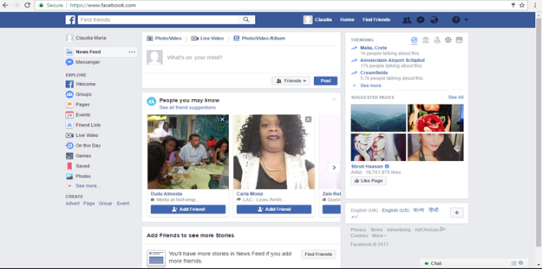
Figure 2:2nd Step
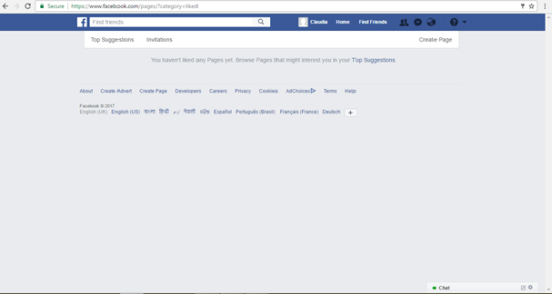
Figure 3:3rd Step
- In this step, the page was selected and was ready to be created.
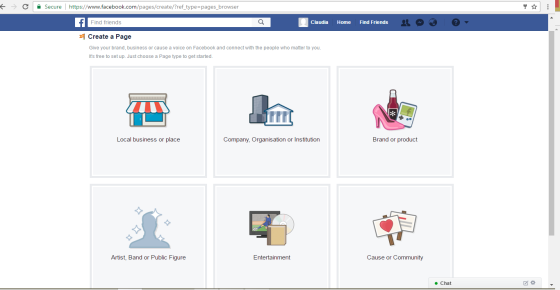
Figure 4:4th Step
- The primary purpose of creating the Facebook was to connect with the people by using a brand, business or a cause. In this case, the cause or community was chosen to continue with the further step.
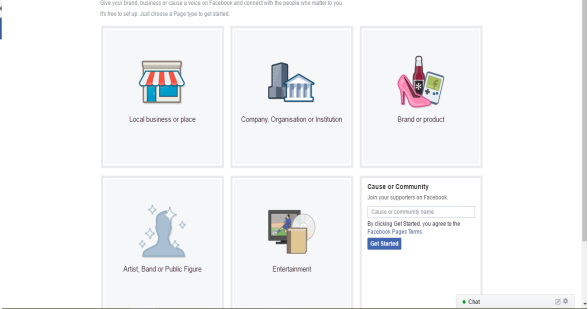
Figure 5:5th Step
- By clicking on “get started” and after writing the name for the page, the Facebook page was created as illustrated below.
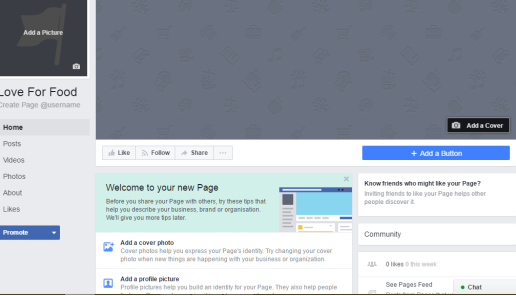
Figure 6:6th Step
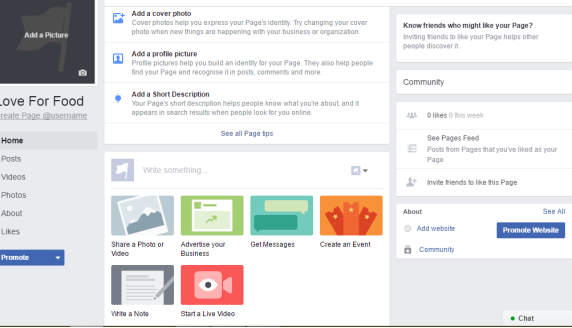
Figure 7: Page Created
The creation of the Facebook page has enabled the company to attract a number of people at the same time. The page also got about 30 likes. The page has also been receiving comments for the photos and the videos that were uploaded by Love for Food. Hence, this procedure has been useful in the attainment of the objectives.
Analysis of your experiment area:
Page Views:
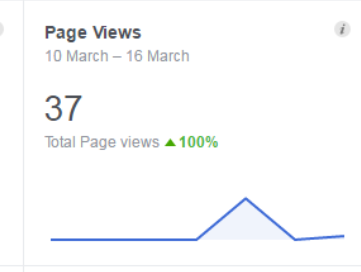

The above analysis of data identifies that the company has become successful to generate 37 views for its Facebook page. The page was run for 3 weeks. Within this small period it has been successful to generate sufficient views. The above chart also shows the sources of views was not only from facebook.com, but also other key websites such as likestool.com, traffup.net also facilitated to increase the number of views the page. This shows the company can get higher reach through Facebook promotions.
Page Likes:

The above data shows that the enterprise has been able to increase the likes of the page from 17th Feb to 17th March. The firm has been successful to the likes of pages to a certain extent from 15th March.
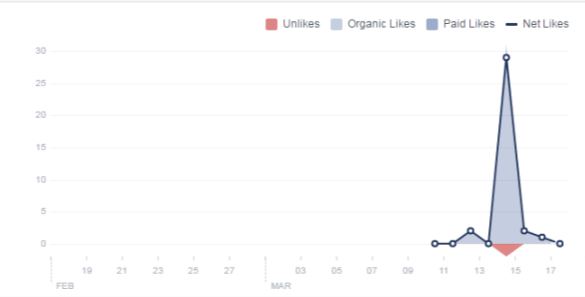
The above chart also represents that the number of likes has been decreased drastically from 16th march. This represents that the business has not been successful to sustain its market presence. According to the AIDA model, the enterprise requires to attention generation, interest development, desire generation and resulting action i.e. purchasing of services (Hassan, et al., 2015). But, above analysis shows the company has been successful to generate attention for the product. It has also been successful to develop interest (Wang, 2014). But as the organisation has failed to sustain these factors for long, it has not been successful to generate desire and purchase decision. Thus it failed to meet its target of generating high degree of return on investment from the projectReflections upon the use of Facebook/Facebook Insights:
Pages on Facebook are public in nature and hence, the engagement with the pages are also public. Initially, with the incorporation of Facebook Insights in my project, I learnt that Facebook insights assists in providing insights to the managers of the page along with the activity of the people on the page (Bharadwaj, et al., 2013). I learnt that Facebook insight is a powerful tool for the individuals who are determined towards the tracking of the interaction of the user on the fan page of the Facebook. It can be seen by each and every admin of the page. I also learnt that it aids in understanding the performance of the page with the help of graphs.
In the course of using Facebook insights, I learnt that we will also be able to recognise and determine the “best time of the day” along with the “best day of the week” for posting pictures and contents on the Facebook page (Gerlitz & Helmond, 2013). Further, it is also mandatory to mention that I also learnt that Facebook Insights are also useful in understanding the use and power of a particular content or post (Frick, 2000). One of the most important things that I learnt was it is a tool that is constantly updated which helps in reflecting the developments in the page. Hence, it is essential to keep a check on the loop.
The study identifies that the company has chosen social media for promotional perspective. Since, it is cost effective and has high reach. The other process of analysis for studying the effectiveness of promotional strategies thus has been rejected. These promotional strategies can be identified as multivariate analysis and A/B analysis. The analysis of data also shows; the organisation has been failed to meet its promotional objective as it has failed to sustain the interest. In theoretical perspective of AIDA model (Ward & Peppard, 2016), the enterprise has not been quite successful in generating demand and purchase intention for its products. However, the study has been very beneficial and informative to develop analytical skills. So, it will add value in academic and professional endeavours.
Abell, L. & Brewer, G., 2014. Machiavellianism, self-monitoring, self-promotion and relational aggression on Facebook. Computers in Human Behavior, 36(1), pp. 258-262.
Bharadwaj, A., El Sawy, O., Pavlou, P. & Venkatraman, N., 2013. Digital business strategy: toward a next generation of insights.. s.l.:s.n.
Chaffey, D., Smith, P. R. & Smith, P. R., 2012. eMarketing eXcellence: Planning and optimizing your digital marketing. 2nd ed. s.l.:Routledge.
Facebook.com, 2017. Love For Food. [Online]
Available at: https://www.facebook.com/Love-For-Food-264565583984164/
[Accessed 17 March 2017].
Frick, T., 2000. Return on engagement: Content, strategy, and design techniques for digital marketings.. London: Taylor & Franci.
Gerlitz, C. & Helmond, A., 2013. The like economy: Social buttons and the data-intensive web.. New Media & Society, 15(8), pp. 1348-1365.
Hassan, S., Nadzim, S. & Shiratuddin, N., 2015. Strategic use of social media for small business based on the AIDA model. Procedia-Social and Behavioral Sciences, 172(1), pp. 262-269.
Miller, M., 2012. B2B digital marketing: Using the web to market directly to businesses. London: Que Publishing.
Royle, J. & Laing, A., 2014. The digital marketing skills gap: Developing a Digital Marketer Model for the communication industries.. International Journal of Information Management, 34(2), pp. 65-73.
Segura, S., Fraser, G., Sanchez, A. & Ruiz-Cortés, A., 2016. A survey on metamorphic testing. IEEE Transactions on Software Engineering, 42(9), pp. 805-824.
Selwyn, N. & Facer, K., 2007. Beyond the digital divide – Rethinking digital inclusion for the 21st century. UK: Futurelab.
Wang, P. e., 2014. Graphical representation of multivariate data. 2nd ed. London: Elsevier.
Ward, J. & Peppard, J., 2016. The Strategic Management of Information Systems: Building a Digital Strategy. London: John Wiley & Sons.
Young, A., 2014. Brand media strategy: Integrated communications planning in the digital era. Basingstoke: Palgrave Macmillan.